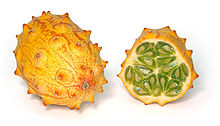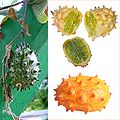- Horned melon
-
Horned melon 
Cucumis metuliferus fruit Scientific classification Kingdom: Plantae (unranked): Angiosperms (unranked): Eudicots (unranked): Rosids Order: Cucurbitales Family: Cucurbitaceae Genus: Cucumis Species: C. metuliferus Binomial name Cucumis metuliferus
E. MeyThe horned melon (Cucumis metuliferus), also called African horned cucumber or melon, jelly melon, hedged gourd, English tomato, melano, kiwano, or cherie, is an annual vine in the cucumber and melon family. It is considered to be the ancestor of the other cultivated melons. Often known by its nickname in the southeastern United States, blowfish fruit, it is grown for its fruit, which looks like an oval melon with horn-like spines. The fruit of this plant is edible, but it is used as often for decoration as for food. When ripe, it has a yellow-orange skin and a lime green jelly-like flesh with a tart taste, and texture similar to a cucumber. The horned melon is native to Africa, and it is now grown in California, Chile, Australia and New Zealand as well.[1]
In Zimbabwe, this cucumber is called 'gaka' or 'gakachika' and it is primarily used as a fruit-snack, salad, and, rarely, for decoration. It is eaten young, mature green, or when ripe - bright yellow/orange (i.e., at any stage of its development). It grows naturally in the fields and also in the bush. However, some people leave some to rot in the fields for next summer seeds/plants. Its taste has been compared to a combination of cucumber and zucchini[2] or a combination of banana, cucumber and lemon.[3] Some eat the peel as well. The fibrous structure and protein composition of the peel provides for a taste and texture similar to the plantain family. It has a replica that does not have horns, but looks and tastes similar. The seeds are covered in a gelatin-like substance. The skin is very rich in vitamin C and fiber. A small amount of salt or sugar can increase the flavor. The fruit can be used in cooking, but when eaten raw, most suck out the pulp and spit out the seeds, although eating the skin and/or the seeds is also known.
Horned Melon, raw Nutritional value per 100 g (3.5 oz) Energy 183 kJ (44 kcal) Carbohydrates 7.56 g Fat 1.26 g Protein 1.78 g Water 88.97 g Vitamin A equiv. 7 μg (1%) - beta-carotene 88 μg (1%) Thiamine (vit. B1) 0.025 mg (2%) Riboflavin (vit. B2) 0.015 mg (1%) Niacin (vit. B3) 0.565 mg (4%) Pantothenic acid (B5) 0.183 mg (4%) Vitamin B6 0.063 mg (5%) Folate (vit. B9) 3 μg (1%) Vitamin C 5.3 mg (6%) Calcium 13 mg (1%) Iron 1.13 mg (9%) Magnesium 40 mg (11%) Manganese 0.039 mg (2%) Phosphorus 37 mg (5%) Potassium 123 mg (3%) Sodium 2 mg (0%) Zinc 0.48 mg (5%) Percentages are relative to US recommendations for adults.
Source: USDA Nutrient DatabaseContents
Gallery
Uses
A traditional food plant in Africa, this fruit has potential to improve nutrition, boost food security, foster rural development and support sustainable landcare.[4][not in citation given] Despite the fruit's colorful appearance, it has not found any significant uses in Western cusine, and has been called "astringent," and the prices "exorbitant." [5]
In terms of chemical makeup it is similar to others in the family Cucurbitaceae.
In popular culture
The Fruit appeared in an episode of Friends; "The One Where Ross Dates a Student".[6] In the episode "Awakened" in the second season of Charmed, it appeared as a carrier of the tsetse fly that bit Piper.
References
- ^ "Horned Melon: Information and Health Benefits". Exotic Fruit for Health. 31 August 2011. http://www.exoticfruitx.com/2011/08/horned-melon-information-and-benefits/. Retrieved 19 November 2011.
- ^ "Kiwano: It's what's inside that counts", The Seattle Times.
- ^ "Let's discover some more little-known fruits", Deseret News.
- ^ National Research Council (2008-01-25). "Horned Melon". Lost Crops of Africa: Volume III: Fruits. Lost Crops of Africa. 3. National Academies Press. ISBN 978-0-309-10596-5. http://books.nap.edu/openbook.php?record_id=11879&page=89. Retrieved 2008-07-17.
- ^ Elizabeth Schneider. Vegetables from Amaranth to Zucchini. William Morrow. p. 345. ISBN 0-688-15260-0.
- ^ "The One Where Ross Dates a Student Trivia and Quotes", tv.com.
Melon Bailan melon • Bitter melon • Canary melon • Cantaloupe • Citron melon • Citrullus ecirrhosus • Cucumeropsis mannii • Galia • Hami melon • Honeydew • Horned melon • Melon ball • Montreal melon • Muskmelon • Paddy melon • Piel de Sapo • Santa Claus melon • Sprite melon • Sugar melon • Sun Melon • Watermelon • Watermelon steak • Winter melon • Yubari KingCategories:- Melons
- Cucurbitaceae
- Desert fruit
- Fruit stubs
Wikimedia Foundation. 2010.




